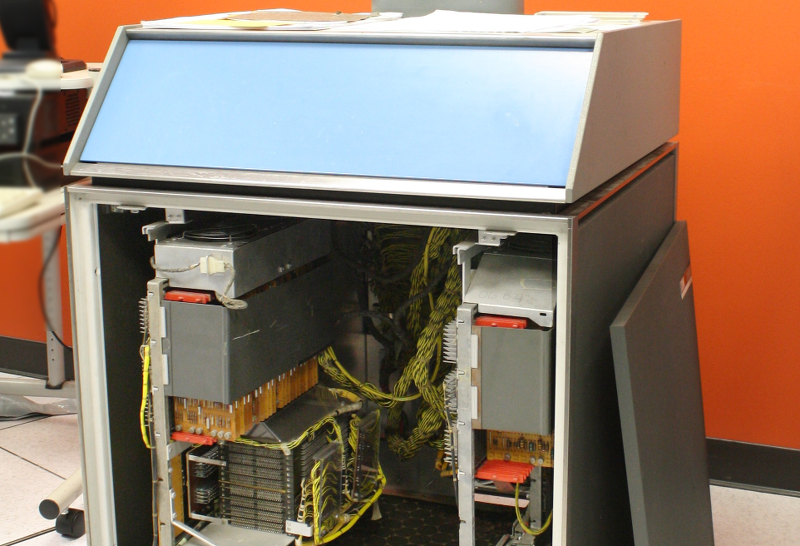If you find yourself in the vicinity of Mountain View, California you really should stop by the Computer History Museum. Even if you aren’t into the retrocomputer scene, there’s so much cool hardware ranging from a replica of the Babbage engine to nearly modern PCs. There’s even a room dedicated to classic video games. There are two fully working old computers at the museum that have their own special rooms: a PDP-1 (complete with vector scope to run Space War) and an IBM 1401.
The IBM 1401 looks like big iron, but in its day it was a low-end machine (costing an innovative business about $2500 a month). The base unit had 4000 words of magnetic core memory, but if you had a hankering for more memory, you could add the 350 pound dishwasher-sized IBM 1406 (for only $1575 a month or you could buy for $55100). How much memory did you get for $18900 a year? An extra 12000 words!
The problem is, the museum’s 1406 had developed a problem. Some addresses ending in 2, 4 or 6 failed and they were all in the same 4K block. [Ken Shirriff] was asked to go in and try to find the problem. We don’t want to give away the story, but [Ken] wrote up his experience (with lots of pictures).
You won’t find spoilers here, but we will point out that it is interesting to see that the machine was a decimal machine (not binary) and it used what we now think is a peculiar encoding. It was essentially a digital representation of a punched card. Seems strange now, but in 1959 it made sense (the 1401s operated until the early 1970s).
If you can’t make it to the museum, [Ken’s] post is a pretty good substitute (plus, see the video below) and a good detective story, as well. If you think these computers can’t do anything practical, it might surprise you to know someone was able to mine for Bitcoin on this very computer (well, sort of) and even produce Mandelbrot sets. We wonder in 2065 what they’ll think about the size and price of our memory and computers.















SPOILER
So the answer to the problem was pull the cartridge, blow on the contacts, and plug it back it.
Hmmmmm!
Well… yeah but which card to pull? That’s the trick. Reminds me of the Henry Ford story: http://www.smithsonianmag.com/history/charles-proteus-steinmetz-the-wizard-of-schenectady-51912022/?no-ist
Please don’t let AI Williams make you think your subtle reference went un-got. LOL
Just for fun I used the inflation calculator 55,000 in 1962 == a round $433,000 today.
Sheesh. And I know people that refuse to throw $300 into a new computer…
computing power has become mind numbingly cheap. Take a look at the size of that box and all those hand built parts.
My point was that some folks these days have no idea just how good we have it, being able to purchase extremely powerful computers for less than the cost of a month’s groceries (give or take).
Most of $55K is know how, not material or labour.
We enjoy great liberalization of knowledge, this leads to competition and cheap prices. Of course scale helps too ;)
Good write up, but as someone who fixed Univac mainframes in the 60’s-80’s, this was all in a normal day’s work. If this took more than 1 hour to fix, we had to call our branch manager (system down time rules in the maintenance contract.) Not enough to swap parts, you were expected to get to the component. Enough different cards in a system that you couldn’t rely on having a spare for each. Even more ‘fun’ when the spare was defective and changed the symptoms! :-) It taught you to recognize symptoms and undo what you last changed.
Yep, todays Computer Techs and IT guys dont know anything about the hardware compared to the old days when you were diagnosing at the component level. Back when an EE degree was required and computer rooms were properly designed…
I still remember troubleshooting a Liebert environmental unit because it was flooding the raised floor. Ankle deep in water under the raised floor trying to unplug a drain by hand…
Ah memories. I cut my teeth on a Univac 1108. EXEC 8… CI… I still have most of my old books on it. Of course, we were not allowed anywhere near the hardware ;-)
Cool read. Thx for posting it for us!
Wow. I was just there two months ago in that room. They had that unit opened up working on it. Cool!
I think I have seen one when I was younger, I was amazed even then.
Cool stuff to work on. I am sure when it was in active use figuring out problems like this was standard practice. Now it has become a reinvent the wheel thing.
The earliest IBM 360’s had a “1401 emulator” module that allowed the 360 to execute 1401 machine code.
So, 1971 on Long Island, it was a Sigma 7, FAST ASYNCHRONOUS, w/ floating point (FP) problem; after “Wal. S.” “milked” it for day$ of O.Time, the 4(8″x5″)PCBs just needed me to swap them, a coupl’a times, re-running the diag. and “VOY-OLAH” the bad pcb got swapped with my gud spare.
Wal S. hated my guts, but I was a HEE-ROW!